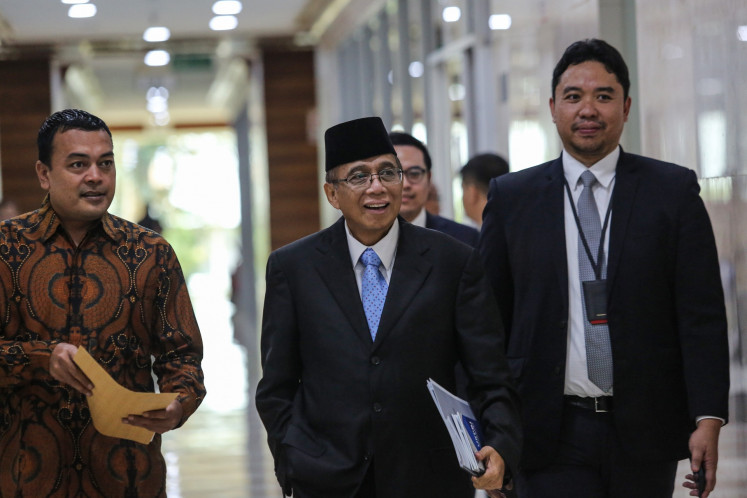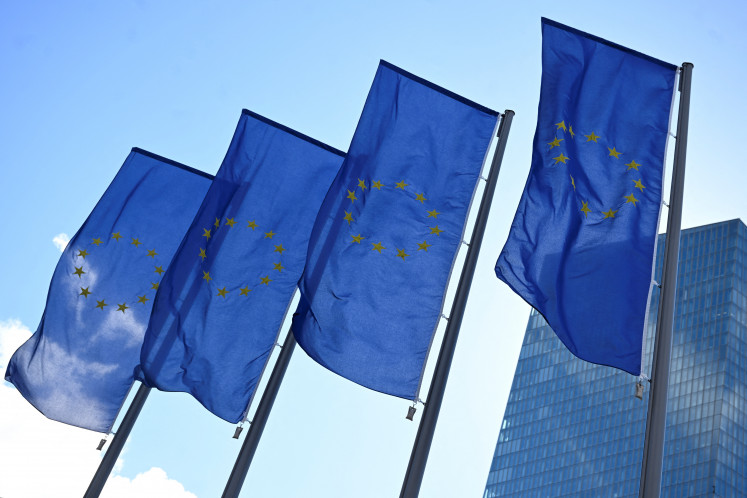Popular Reads
Top Results
Can't find what you're looking for?
View all search resultsPopular Reads
Top Results
Can't find what you're looking for?
View all search resultsPupuk Indonesia eyes capacity boost from new facilities
State-owned fertilizer producer Pupuk Indonesia Holding Company (PIHC) expects that its newly built and already existing facilities, some of which are being expanded, will help boost the firmâs production capacity in the next five years
Change text size
Gift Premium Articles
to Anyone
S
tate-owned fertilizer producer Pupuk Indonesia Holding Company (PIHC) expects that its newly built and already existing facilities, some of which are being expanded, will help boost the firm's production capacity in the next five years.
The company, which manages numerous fertilizer manufacturers, is expected to increase its total production capacity to 19 million tons in 2019 from the current 12.9 million tons, according to its executive.
'We have sufficient production capacity, but hope for more growth following recent and future expansions of newly constructed and already existing facilities,' PIHC president director Arifin Tasrif said after a closed-door meeting Wednesday with House of Representatives Commission IV overseeing agriculture, plantation and fisheries.
The PIHC Group has five companies in fertilizer and basic chemical manufacturing industries: Pupuk Iskandar Muda in Aceh, Pupuk Kaltim in East Kalimantan, Pupuk Kujang in West Java, Pupuk Sriwidjaja Palembang (Pusri) in South Sumatra and Petrokimia Gresik in East Java.
The PIHC has reportedly spent Rp 5 trillion (US$387 million) on projects to be completed in the next five years, including $500 million to $650 million on Pupuk Kaltim's PKT 5 urea fertilizer production plant in East Kalimantan, $690 million on Pusri's IIB urea plant in Palembang and an unspecified amount on the new phosphoric acid plant in Gresik, East Java.
Reports suggest Pupuk Kaltim's PKT 5 and Petrokimia Gresik's new plants will be ready for operation this year. The new plant in Gresik is being managed by a joint venture between Petrokimia Gresik and Jordanian firm Jordan Phosphate Mines Co. with an expected total production capacity of 200,000 tons a year. Pupuk Sriwidjaja's Pusri IIB plant should be running by yearend.
Arifin said the PIHC expected its new project in Bintuni Bay, West Papua, would begin soon as a feasibility study had earlier been halted when the gas supply was postponed.
'We are ready to start construction once we have a consistent supply of gas,' Arifin said.
The PIHC is developing the Rp 31.4 trillion Bintuni Bay industrial estate in West Papua in collaboration with German firm Ferrostaal AG and South Korean giant LG International. The project will support Indonesia's petrochemical industry.
Arifin earlier said that total gas needs for all PIHC plants totaled to 700 or 800 million cubic feet per day (mmcfd) and that part of this need could be satisfied with coal.
He also said the company expected the increase in production capacity to support the government's subsidized fertilizer program, for which there was a mismatch between supply and demand. The PIHC, according to Arifin, currently provided 9.55 million tons of subsidized fertilizer, a figure that would increase to 14.9 million tons next year.
According to the Agriculture Ministry, the state is subsidizing 9.5 million tons of fertilizer this year, assuming that nationwide fertilizer consumption stands at
around 800,000 to 900,000 tons per month. Currently, Indonesia consumes 15.2 million tons of fertilizer annually.
'Expanded facilities will help us meet subsidized fertilizer allocations [...]. We aim for 19 million tons in the next five year,' PIHC corporate secretary Budi Asikin said.
Budi said 70 percent of the PIHC's current fertilizer production was for the subsidy program, while the remaining 30 percent went to non-subsidized ends. In order to maintain profit margins, Budi said the group traded fertilizer, led by subsidiary Mega Eltra.
'We also export our fertilizer to ASEAN countries, such as Myanmar, Vietnam and the Philippines, as well as Australia,' Budi said.










